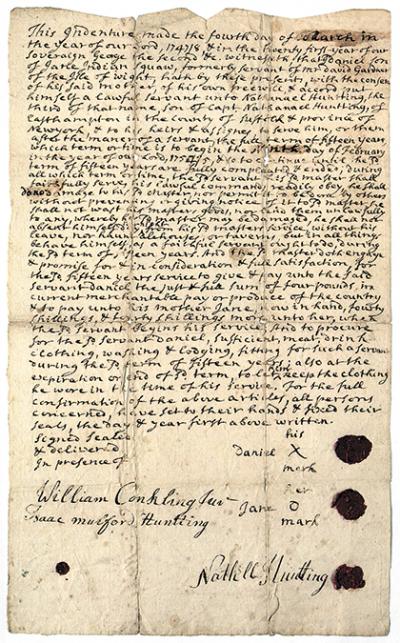The Indenture of Daniel, 1747

In 1747, Daniel, “son of Jane, Indian Squaw, formerly a servant of Mr. David Gardiner of the Isle of Wight” — Gardiner’s Island — signed the indenture seen here to Nathaniel Huntting (1730-1801) for 15 years’ service. An indenture is a legal contract that reflects or covers a debt or purchase obligation. In this context, it refers to an indentured servant’s status. While indentures were fairly commonplace in colonial America, this particular one was a bit unusual because it involved Native Americans and specified expectations for Daniel’s conduct during his contract.
Gardiner’s Island, like other Long Island manors, relied on Native Americans and enslaved labor to operate. It’s unclear whether Daniel’s mother was a free indigenous person who worked for the Gardiner family or if her servitude was also indentured or even enslaved. On March 4, 1747/8 (the date so written because of the 18th-century Gregorian calendar change), when this indenture was signed, Jane received 40 shillings, and in 1754/5, when Daniel’s indenture began, she received an additional 40 shillings.
Although Daniel’s indenture didn’t begin for almost seven years after the signing, and payment was given to his mother, Daniel was probably still fairly young at the time. At the end of his indenture, Daniel himself received 4 pounds or equal value of crops and the clothes he wore during this service period.
His indenture stipulated he “do no damage to his [said] master nor permit it to be done by others without preventing or giving notice of it to [said] master, he shall not waste his master’s goods . . . he shall not absent himself day or night from his master’s service, without his [master’s] leave, nor haunt alehouses or taverns, but in all things behave himself. . . .” While these were not unusual expectations for an indenture, seeing them detailed in this way makes them real to us today.
Isaac Mulford Huntting, Nathaniel’s first cousin, and William Conkling Jr. witnessed the agreement, and while Daniel and Jane could not sign their names, both made marks for their signatures. What became of Daniel after his indenture remains unknown.
Andrea Meyer is a librarian and archivist in the East Hampton Library’s Long Island Collection.
